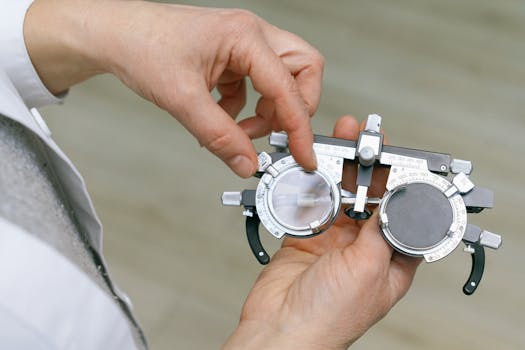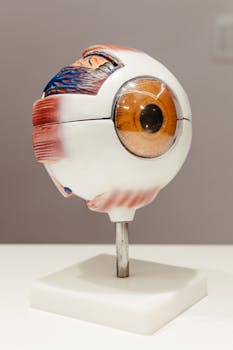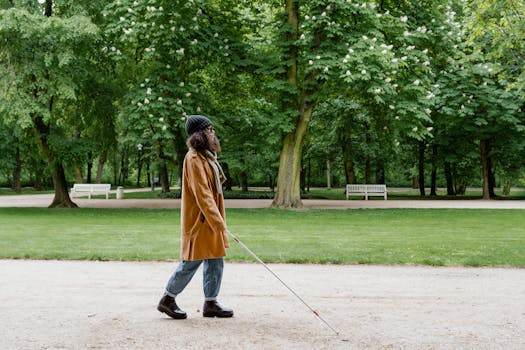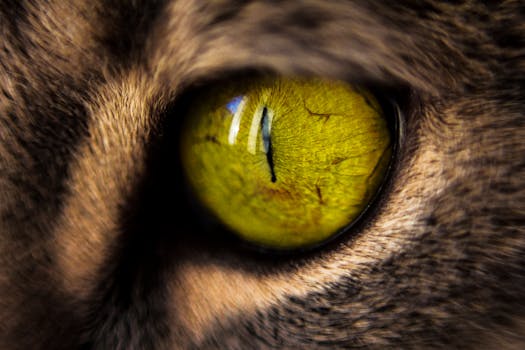Indice
- Introduction: The Fascinating World of Vision
- Understanding Eye Anatomy: Human vs. Animal
- Photoreceptors: How Rods and Cones Capture Light
- The Visual Pathway: From Retina to Brain
- Unique Vision Mechanisms Across the Animal Kingdom
- Vision’s Influence on Photography: Capturing the World Through Lenses
- Videography and Vision: How Animals Inspire Cinematic Techniques
- Ethics in Vision Science: Cross-Species Considerations
- Future Technologies: Enhancing Vision for Humans and Animals
- Conclusion: The Interconnectedness of Vision, Art, and Technology
Introduction: The Fascinating World of Vision

The Complexity of Vision
Vision is one of the most intricate and vital senses for both humans and animals. The human eye, with its approximately 2 million working parts, is a marvel of engineering. This sophisticated organ enables us to perceive our environment by detecting light and converting it into the images we see. Animals have developed various eye structures adapted to their specific needs; for instance, raptors have sharp vision that allows them to spot prey from great distances, while some nocturnal creatures possess eyes that can capture more light, aiding night vision.
How Vision Works
The process of vision begins when light enters the eye through the cornea, the transparent front layer. It then passes through the pupil, adjusts via the iris, and reaches the lens, which focuses light onto the retina. The retina contains photoreceptor cells—rods and cones—that convert light into electrical signals. These signals are sent through the optic nerve to the brain, where they are interpreted as images. This seamless integration of biological components allows us to perceive a wide spectrum of colors and visual details.
The Evolution of Vision
Vision has evolved differently across species, leading to an astounding variety in the visual capabilities of animals. For instance, some insects can see ultraviolet light, which is invisible to the human eye. The structure of the eye has adapted to enhance survival; for example, the placement of eyes on a prey animal allows for a broader field of view to detect predators. Understanding these distinctions not only sheds light on the evolutionary biology of species but also offers insights into improving optical technologies, including photography and videography, enhancing our capability to capture the world around us.
Understanding Eye Anatomy: Human vs. Animal

Basic Structure of the Human Eye
The human eye is a complex organ, composed of several essential parts that work together to facilitate vision. Key components include the cornea, iris, pupil, lens, retina, and optic nerve. The cornea refracts light entering the eye, while the iris controls the pupil’s size, modulating the amount of light that reaches the lens. The lens further focuses this light onto the retina, the inner layer where photoreceptors—rods and cones—convert light into electrical signals. These signals travel via the optic nerve to the brain for interpretation, enabling us to perceive images.
Animal Eye Variations
Animal eyes can vary significantly from human eyes, reflecting adaptive traits suited to their environments. For example, many prey animals, like rabbits, have eyes placed on the sides of their heads, providing a nearly panoramic field of view to detect predators. In contrast, predators, such as lions, have forward-facing eyes that enhance depth perception and focus. Additionally, some species, such as cats, possess a reflective layer behind the retina known as the tapetum lucidum, which improves their night vision by reflecting light back through the retina. These adaptations demonstrate the incredible diversity in visual systems across the animal kingdom.
The Influence on Photography and Videography
Understanding the anatomical differences between human and animal eyes can significantly impact photography and videography. Photographers often take advantage of specific characteristics of animal vision, such as the broader dynamic range and enhanced sensitivity to light that nocturnal animals possess. Capturing images that reflect these unique vision qualities can create a more profound visual narrative in wildlife photography. Additionally, insights gained from animal eye anatomy can lead to the development of new optical technologies, further enhancing our ability to capture and reproduce images that reflect the richness of life on Earth.
Photoreceptors: How Rods and Cones Capture Light

The Role of Rods in Vision
Rods are one of the two types of photoreceptor cells located in the retina, specifically designed to detect low light levels. They are highly sensitive to light, allowing us to see in dimly lit environments, such as during twilight or in a dark room. There are approximately 120 million rods in the human retina, making them responsible for allowing us to perceive shapes and movement in low-light conditions. However, rods do not contribute to color vision; instead, they primarily detect variations in brightness, which is essential for night vision.
The Function of Cones in Color Perception
Cones are the other type of photoreceptor in the retina, and they are crucial for color vision and sharpness in well-lit conditions. Humans have about 6 million cones, classified into three types based on the wavelengths of light they detect: short (S), medium (M), and long (L) cones, corresponding to blue, green, and red light, respectively. The combination of signals from these three types of cones allows the brain to interpret a wide spectrum of colors, enabling us to experience the richness of our visual environment. Cones are densely packed in the fovea, the central part of the retina, which is why our color perception is sharpest in this small area.
Integration of Rods and Cones for Comprehensive Vision
The cooperative functioning of rods and cones allows the human eye to adapt to various lighting conditions, blending low-light sensitivity with vibrant color perception. This synergy is especially evident in transitional settings, like dusk, where rods begin to take over as cones become less effective. Evolutionarily, this adaptation enhances survival, helping organisms detect predators or prey during different times of the day. Understanding the dynamics between these photoreceptors not only provides insight into human vision but also aids in advancements in photography and videography, specifically in improving techniques for capturing images in varying light conditions. Photographers can leverage knowledge of these mechanisms to create images that replicate the nuanced perception of light and color, making their work resonate more deeply with viewers.
The Visual Pathway: From Retina to Brain

The Journey of Light through the Retina
The visual pathway begins its intricate journey when light is captured by the retina, a thin layer of tissue located at the back of the eye. The retina contains two types of photoreceptors: rods and cones. These specialized cells transform light into electrical signals. Rods are primarily responsible for vision in low-light conditions, while cones are necessary for daylight and color vision. Once the photoreceptors are triggered by incoming light, they generate a cascade of biochemical signals that culminate in the creation of an electrical impulse. This critical process forms the basis of visual perception.
From Retina to the Optic Nerve
After the retinal photoreceptors convert light into electrical signals, these signals are transmitted to bipolar cells, which then relay them to ganglion cells. The axons of the ganglion cells form the optic nerve, a bundle of nerve fibers that exits the eye and serves as the primary conduit for visual information. It is noteworthy that each optic nerve contains approximately 1.2 million fibers, efficiently transporting visual data from each eye to the brain. This pathway is crucial for the integration of visual input, which ultimately shapes our perception of the surrounding world.
The Brain’s Role in Interpreting Vision
Once the optic nerve carries the visual signals to the brain, they reach the lateral geniculate nucleus (LGN) in the thalamus, where initial processing occurs. This structure is responsible for organizing and relaying information to the primary visual cortex, located at the back of the brain in the occipital lobe. Here, the brain decodes the signals, integrating data regarding shape, color, depth, and motion. The highly organized processing within the visual cortex allows the brain to construct a cohesive visual representation of our environment. This entire pathway highlights the complex interplay between the eye and brain, emphasizing how intricate visual processing influences not only our perception but also aspects of visual art, including photography and videography, by capturing the world’s beauty in relatable forms.
Unique Vision Mechanisms Across the Animal Kingdom
Compound Eyes of Insects
One of the most fascinating adaptations in the animal kingdom is the compound eye, predominantly found in insects and some crustaceans. These eyes consist of thousands of tiny visual units called ommatidia, each providing a separate visual channel. This structure offers insects a wide field of vision and excellent motion detection, enabling them to spot predators and prey effectively. For instance, a dragonfly can have up to 30,000 ommatidia, granting it almost a 360-degree view of its surroundings. While the images produced by compound eyes are less detailed compared to those from human eyes, they are particularly suited for detecting movement and changes in light, essential for survival in the wild.
The Tapetum Lucidum: Night Vision Enhancer
Many nocturnal animals, including cats and dogs, possess a reflective layer behind their retina called the tapetum lucidum. This layer increases the efficiency of photoreceptors by reflecting light that passes through the retina back into the eye, giving it another chance to be absorbed. This adaptation significantly enhances their night vision, allowing them to see in conditions that would be completely dark to humans. The distinctive glow seen in animal eyes at night is a direct result of this structure, demonstrating a fascinating adaptation that enhances their ability to hunt and navigate in low-light environments.
Ultraviolet Vision in Birds and Insects
Some species, particularly birds and insects, have evolved the ability to perceive ultraviolet (UV) light, which is invisible to humans. This extended range of vision allows them to detect patterns and signals in the environment that are not visible to other animals. For example, many flowers have UV-reflective patterns that guide pollinators like bees to their nectar. Birds such as the Eurasian blue tit can see UV light, which plays a vital role in mate selection and foraging. Understanding these unique visual capacities can provide insights into evolutionary adaptations and influence how photographers approach subjects within wildlife, emphasizing patterns that resonate across the broader spectrum of visible light.
Vision’s Influence on Photography: Capturing the World Through Lenses

The Impact of Human Vision on Photography
Human vision plays a crucial role in photography, dictating how we perceive and capture images. The wide range of colors that humans can perceive, facilitated by our cone photoreceptors, influences not only the selection of subjects but also the settings and filters used during shooting. Photographers often manipulate lighting, contrasts, and saturation to evoke emotions or highlight specific details that our eyes naturally gravitate toward. Moreover, understanding concepts like depth of field, focus, and framing is essential for photographers to replicate the way the human eye sees the world, allowing for more compelling narratives within their images.
Incorporating Animal Vision into Wildlife Photography
Wildlife photographers often benefit from understanding the unique visual capabilities of various species. For instance, knowing that many animals possess broader fields of vision or enhanced sensitivity to motion can guide photographers in positioning themselves to capture those animals naturally. Additionally, employing specific techniques that mimic how animals perceive their environments can lead to more authentic images. For example, techniques that highlight UV patterns can attract interest in flowers or birds that are particularly sensitive to these wavelengths, showcasing aspects of nature that would otherwise remain unseen to the human eye.
Technological Innovations Inspired by Vision
The intricate mechanisms of both human and animal vision have contributed to advancements in photographic technology. For example, modern cameras now incorporate features such as high dynamic range (HDR) imaging and low-light capabilities inspired by the functional adaptations of rods and cones. Moreover, understanding the principles behind the tapetum lucidum has led to the development of cameras that can excel in low-light conditions, much like the eyes of nocturnal animals. As technology continues to evolve, the interplay between our understanding of vision and advancements in photography and videography will undoubtedly lead to innovative techniques for capturing the richness and diversity of life on Earth.
Videography and Vision: How Animals Inspire Cinematic Techniques

The Art of Movement: Mimicking Animal Motion
One of the most significant influences of animal vision on videography is the understanding of movement and how different species perceive motion. For example, birds of prey are capable of tracking fast-moving objects in their peripheral vision, enabling them to react swiftly in hunting scenarios. Cinematographers often study these dynamics to create dynamic shots that capture the essence of movement in wildlife. Techniques such as slow-motion captures or high-speed videography mirror the natural motion detection abilities seen in raptors and other predators. By emulating the way animals experience their surroundings, filmmakers can craft compelling narratives that resonate with audiences on a primal level.
Dynamic Range and Color Grading Inspired by Nature
Animals with unique visual adaptations, such as deep-sea creatures or brightly colored birds, inspire filmmakers to explore dynamic ranges and color grading in their work. For instance, cephalopods like octopuses exhibit remarkable abilities to change colors and patterns instantaneously, adapting their appearance to blend into their environments. This exquisite natural phenomenon has prompted filmmakers to harness advanced color grading techniques to evoke emotional responses that parallel these transformations. By mimicking the visual complexity found in animals, videography can elicit a deeper connection with viewers, enhancing the storytelling experience.
Utilizing Lenses to Replicate Unique Visual Perceptions
The specific adaptations seen in various animal eyes have led to innovative lens designs in videography. For example, lenses that emulate the wide fields of view typical in prey animals are becoming more popular for capturing nature footage. Additionally, inspiration from compound eyes, like those of insects, has led to the development of specialized cameras that can capture a more extensive spectrum of light and motion. Such camera systems mirror the multifaceted visual processing found in nature, enabling filmmakers to represent their subjects in more profound and impactful ways. By incorporating these insights into their work, filmmakers can expand the boundaries of visual storytelling, offering audiences a richer, more immersive experience.
Ethics in Vision Science: Cross-Species Considerations
The Ethical Implications of Animal Research
The study of vision across species often involves research that requires the use of animal models. Ethics in vision science necessitates that researchers carefully consider the welfare of these animals. Regulations such as the Animal Welfare Act and guidelines set forth by institutional animal care committees ensure humane treatment. Ethical frameworks advocate for the three Rs: Replacement, Reduction, and Refinement. This means seeking alternatives to animal models, minimizing the number of animals used, and fine-tuning experimental procedures to cause the least harm possible. As science strives to understand vision mechanisms, it is crucial to balance the pursuit of knowledge with a commitment to ethical treatment of research subjects.
Animal Vision and Conservation Efforts
Understanding the visual capacities of different species is vital for conservation efforts, particularly regarding habitat protection and species survival. By studying how specific animals perceive their environment, conservationists can design better strategies to protect their natural habitats. For instance, the knowledge that certain species can see UV light can inform the placement of artificial feeding sites or develop conservation techniques that consider their visual preferences. Ethical considerations in this context emphasize the importance of stewardship over wildlife, advocating for sustainable practices that reflect an intrinsic respect for the interconnectedness of life forms.
Impacts on Artistic Representations in Media
The exploration of animal vision in photography and videography raises ethical questions regarding representation and interpretation of wildlife. Creators must navigate the line between artistic expression and the accurate depiction of species. Misrepresentation can lead to misunderstanding and exploitation of wildlife, as sensationalized portrayals may skew public perception and affect conservation efforts negatively. Ethical media production involves a commitment to authenticity and sensitivity toward the subjects depicted, ensuring that the inherent beauty and ecological roles of species are respected and highlighted accurately in art. A responsibility lies with photographers and filmmakers to inform viewers about the animal kingdom’s stories, fostering appreciation and respect rather than mere spectacle.
Future Technologies: Enhancing Vision for Humans and Animals
Augmented Reality (AR) Systems
Augmented reality (AR) technology holds the promise of enhancing human vision through the superimposition of digital information onto the real world. By using AR glasses, users can receive real-time data, navigation aids, and interactive experiences that enrich their visual perception. In wildlife observation, AR applications can help researchers and enthusiasts identify species instantly by providing visual markers and information overlays. This capability can also benefit visually impaired individuals by using auditory cues and haptic feedback to interpret their surroundings, broadening access to information and experiences that were previously difficult to navigate.
Smart Contact Lenses
Recent advancements in smart contact lens technology aim to transform the way we visualize and interact with our environment. These lenses can incorporate microelectronics and sensors that monitor various health indicators while also projecting information directly onto the wearer’s field of vision. For instance, smart lenses could alert users to changes in their health or provide navigation prompts without requiring them to look down at a device. Moreover, this technology could be adapted for animals, giving researchers insights into their behavior and environment. Such innovative lenses can enhance the quality of life across species by facilitating a seamless interaction with the visual world.
Biomimetic Cameras
Inspired by the unique adaptations seen in the eyes of various animals, biomimetic cameras are designed to replicate these remarkable features. For instance, cameras that mimic the compound eyes of insects can capture wide angles and motion with minimal distortion, providing a more comprehensive view of dynamic environments. These technological advancements seek to expand our photographic capabilities, allowing for greater creativity in capturing scenes that reflect not only human vision but also the intricate complexities found in nature. By reflecting biological innovations, such as ultra-sensitive sensors emulating nocturnal creatures, future cameras can significantly enhance our ability to document and share the beauty of our world.
Conclusion: The Interconnectedness of Vision, Art, and Technology
Vision as a Foundation for Artistic Expression
The intricate mechanisms of vision serve as a foundational element for artistic expression, profoundly influencing fields such as photography and videography. Understanding how light is captured and processed by both human and animal eyes allows artists to manipulate their medium effectively. By leveraging insights into color perception, depth, and movement, photographers and videographers can create compelling narratives that resonate with viewers on a deeper level. This connection between vision and artistic representation highlights the importance of comprehending biological visual systems to enhance creative techniques. As artists draw from the unique capabilities of various species, they not only broaden their creative horizons but also foster a deeper appreciation for the complexities of life.
Technological Advances Shaped by Vision Science
Technological advancements in imaging and optical devices continue to be informed by the mechanisms of vision found in nature. Biomimetic designs in camera technology, inspired by the diverse adaptations seen across the animal kingdom, enable filmmakers to capture scenes that reflect both beauty and realism. Innovations such as high dynamic range imaging and smart lenses draw directly from the evolutionary traits of various species, enhancing the ability to document and share visually rich experiences. As technology progresses and evolves, the synergy between art and vision science will pave the way for new creative avenues, allowing artists to present visual storytelling that engages and captivates their audience.
The Broader Implications for Nature and Conservation
The exploration of vision extends beyond artistic endeavors into the realm of conservation and environmental awareness. By understanding the visual capacities of species, conservationists can develop targeted strategies that respect and protect the intricate ecosystems we inhabit. This intersection of vision, art, and technology encourages a collective responsibility towards the natural world, fostering respectful and informed engagement with wildlife. As we harness our understanding of vision to create compelling narratives, the resulting artistic expressions can inspire advocacy for the preservation of biodiversity and encourage deeper connections with the environment. Thus, the interconnectedness of vision, art, and technology not only enriches human creativity but also emphasizes our role in nurturing and safeguarding the beauty of the world around us.




